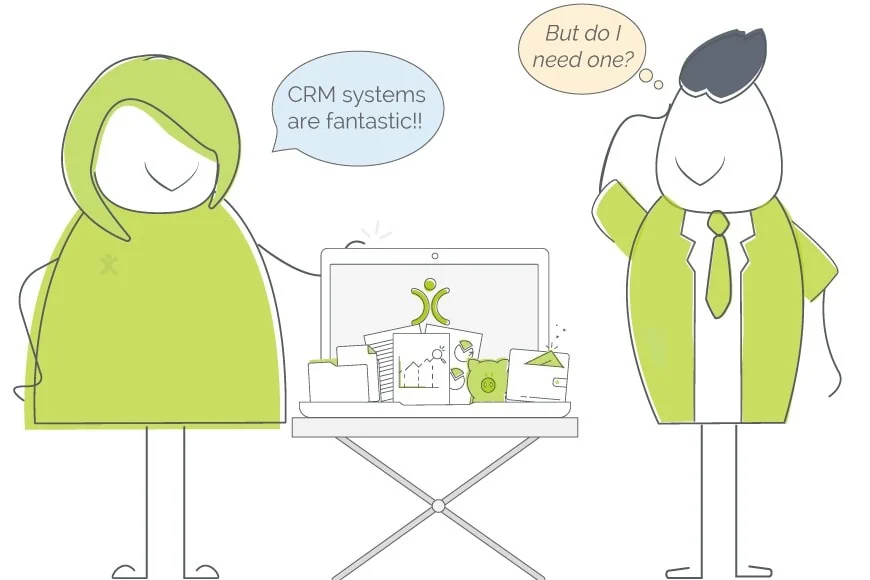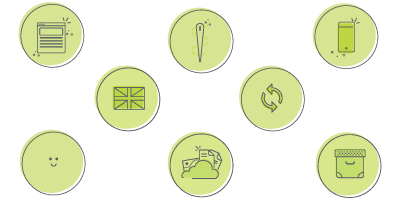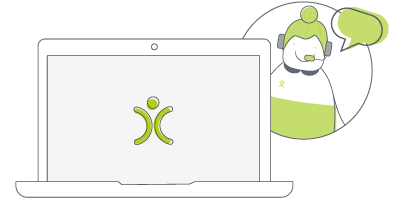Why You Should Use a CRM (and some Best Practices for using your System)
29 Apr 2024
(Republished from an earlier blog)
The question on the minds of a lot of business owners and managers is: Do we really need a CRM system?
Obviously, my answer is going to be YES! I work for a CRM provider, what do you expect?
At the minute, you’re using a combination of systems, tools and processes that work for you. Business is still coming in the door, so why change?
So, instead of asking whether you and your team should use a CRM system, I’m going to ask you a different question:
Could you be more productive?
The answer is almost certainly yes. While it’s not the be-all and end-all, using a CRM system is one of many steps that can help your team be more productive and efficient in their daily work.
So, instead of trying to convince you to sign up for Open CRM, I’d like to talk about some of the pain points we hear from businesses looking for a CRM system. And discuss how a CRM system can help with these pain points and a few best practice tips.
Then we can talk about some key indicators that your business may also need one. And how you can go about implementing a CRM strategy to ensure it is a success for you.
Why Use a CRM?
This is a pretty basic question, but one that has a different answer for every business. That’s not me being difficult (promise). It really does come down to the needs and processes of the individual company or team.
The question we prefer to ask is: what are your pain points?
What are the areas in your business that aren’t working as well as they should? Then we examine them to see where and how OpenCRM could help out.
Some of the most common pain points revolve around sales, but there are others. For example:
- We don’t know what prospects are coming in, when they land, and who is picking them up.
- Forecasting sales is a big problem for us, each salesperson has a different method of reporting their figures.
- Our support team really struggle with keeping track of all the tickets on their desks. This means they aren’t responding in a timely manner.
- I never know who is doing what on which day. I just need to have a better oversight of the company in general.
- We have a set way of doing things that worked when the company was just the three of us. Now that we’re growing, things are a bit disorganised.
- We just spend so much time on the admin of sales that we aren’t selling as much as we could.
And so on.
You might see your business echoed in some of these comments, or you might have a completely different experience.
All companies are different and so will need a CRM to work in different ways—hence why the question of “why do I need a CRM?” is so tough to answer.

Do we have what it takes?
We don't restrict which features you have access to in OpenCRM based on how many users you have. You get everything right out of the box. Click to find out if we've got the features you need.
find out moreHow does a CRM System help?
When deciding whether you need a CRM (and which one you want to use), knowing your pain points is only the first step. You then need to know which CRM system will best address them in practice.
Big brands use CRM to provide a personalized customer experience, increase engagement with existing customers, and resolve customer issues before they escalate into a more serious problem.
Let’s go through the pain points I mentioned above to talk about some options available to you:
Prospect / Lead Management
This is the thing (or one of the things) that people point to as the foundation of CRM systems as an industry. Managing where your Leads (or prospects) are coming from and assigning them to the relevant salespeople is one of those small but significant jobs your CRM can do so well.
You might be imputing these Leads manually or having them automatically come in via your website (or other system). You might want to assign them by set rules or just a more generic Round Robin.
Regardless, simplifying that job can be a huge performance boost for your sales and marketing team(s).
Forecasting Sales
Another staple of the CRM world. When you’ve got your sales team using your CRM system, you’ll be able to use your Opportunity Pipeline to view (and assign probabilities to) upcoming sales by how likely they are to close. This gives you a window into your revenue for the coming weeks and months.
Some research suggests that a CRM can increase your sales forecasting accuracy by as much as 42%.
Obviously, this whole process is very unique to each business, depending on different sales stages and opportunities lifetimes. A best practice tip, if I may, is to spend the time right at the beginning of your CRM implementation to get this configured to your exact business needs. Once you do, that pipeline becomes hugely valuable.
Support / Customer Service Management
If your business conducts any customer support and you’re not using a CRM with HelpDesk functionality, I honestly don’t know how you keep track. Systems like this will create Tickets automatically from an email, send automated responses, and alert your customer service team when there’s been a reply or a Ticket is approaching SLA…the list goes on and on.
This kind of investment in customer service and success can have huge implications for customer retention. Capterra’s CRM research shows that 47% of businesses found that their customer retention and satisfaction rates significantly improved after implementing a CRM system. This was the biggest impact of any one thing.
Giving your support team the tools they need to manage this essential part of your business is essential.

What do you get with OpenCRM?
Unrivalled customer support? 2TB of storage per account? Data held in EU? It's the sort of stuff we think you should be able to take for granted, but which you won't necessarily get from our competitors.
find out moreCompany Oversight
Being able to Report on everything that happens within your CRM system is a huge win from a managerial standpoint. This isn’t about playing Big Brother (the show or the book); it’s about knowing what is going on with your business at any one time. Just imagine receiving an email every morning (or once a week) showing you:
- How many Leads were created,
- What Opportunities are likely to close,
- How many Tickets have been opened,
- Which Invoices are outstanding … and so on.
Your CRM system records all of this stuff. Why wouldn’t you use it to regularly perform a health check on your business?
Mo’Staff, Mo’Problems
Growing your business isn’t generally seen as a problem. But getting everyone singing from the same song sheet as you grow certainly can be a challenge.
By having custom fields, organised in a sensible way, with automated tasks running in the background, you can be sure that your new team members will pick up your processes a whole lot easier.
Best practice tip: if you can, use a Document or FAQ within your CRM system to outline your various processes and procedures. That way everyone can find them in this, your business’ central repository.
Sales (and other) Admin
Sending follow-up emails, remembering dates/times of appointments, getting the right notes together for those meetings, keeping track of essential renewals and other dates…this admin side of sales (and business in general) is so much work.
Except when you have all of this information in a central location, like a CRM…and when you can automate reminders and follow-up emails and all sorts of helpful stuff like that.
CRM Strategy: Making it work for you
In the above two sections, I’ve discussed knowing your pain points (and processes) and how a CRM system can help address them.
Hopefully, you’re starting to come ‘round to my way of thinking, that all businesses should use a CRM system. And if so, then the next step is to think about your CRM strategy.
I don’t mean how to implement one (although I will discuss that in the next section).
When I say “CRM strategy”, what I mean comes down to having the answers to a few key questions:
- Where a CRM needs to fit in your business,
- What kind of tools that CRM needs to have,
- Who will be using which parts of the CRM,
- How will they be using the various CRM elements (best practices), and
- How is that going to evolve over time?
This strategy will evolve over time, as any good strategy does. You might find a CRM that does MORE than you expected, so you will start to build that into your strategy.
Back in 2014, a study showed that the right CRM system will return as much as $8.71 for every $1 spent! Imagine what that’s increased to now!
The important thing in all of this is that you have a strategy. You need to know why you want a CRM and how you want to use it…all before making those first calls to providers.
CRM Implementation
Quite often, people think that once they’ve selected and purchased their CRM system, the hard part is over.
I’m sorry to be the one to tell you, but the hard part is just beginning. But the payoff is worth the work!
Let me walk you through an ideal implementation. That way, you can see what I mean about there being a lot of work in this process:
Step 1: CRM selected
Hooray!
Step 2: Review your CRM strategy
Hopefully, this was a big part of your sales process, so this is really just a way to boost your memory.
This is more than just something to do right at the beginning, as well. It’s a good habit to get in throughout the process
Step 3: Appoint a CRM Champion
Your CRM Champion is someone who will take charge of the configuration and training. They will make sure you are getting the CRM your business needs and help work out your best practices.
Step 4: Configuration
This may be something you do on your own or a process you do alongside your CRM provider. But it is a big part of making sure your CRM works for you. This configuration may include:
- Setting up your email signatures (and email templates)
- Creating your PDFs (for sales, marketing, projects, etc.)
- Adding custom fields and changing the layouts of the screens so they work for your team
- Setting up your permissions to make sure your data is only visible to the people who need it
- Adding any automation or workflow that will support your teams
- Etc.
Step 5: Training
Now you need to make sure that everyone who will be using the CRM is trained in how your processes will be implemented in this new system.
Step 6: Launch
You start using the system (hooray!). (See my tips below for getting people using this new system).
Step 7: Review
At some point after launch, conduct a review with the various teams to find out how the system is working for you, is it solving all the pain points? Has it created any new ones? Do all the processes work as well as they did before?
You can see that even this cut-down process is fairly involved and, depending on the size and complexity of your business, will take a fairly significant investment of time.
My advice for succeeding with your CRM implementation: be involved and be patient. It will take a bit of time, but will require you (and your CRM champion) to be involved if the CRM is truly going to reflect your business.

Let us take you on a tour
You've had a look around and are starting to think OpenCRM might be the system for you and your business. Why not chat with one of our team (and ask your burning CRM questions) as they take you on a tour of the system?
find out moreCRM Best Practices & Top Tips
Now that you’ve resolved which CRM you need, how you’re going to use it and got it all implemented, it’s time to get on with the habit of using it.
And it is a habit your team will need to get into. They will want to go back to the old way of doing things, because it’s what they are comfortable with.
So how do you get them to use this new system in the right way?
- Rewards: some companies like to find ways to reward their users for using the new systems. They might base commission on it or set certain KPIs directly off the back of actions in the system.
- Punishment: the flip side of the reward system is of course punishing people for not using it. For example, withholding commission or bonuses, or even raising disciplinary actions in the extreme, when a person doesn’t use the system.
- Knowledge: my preference and the one I’ve seen used with success in CRM implementations is to take the time to inform people about why you’ve got the system and get them on board with using it. When people understand the reasons and benefits of using a new tool, they are far more likely to use it.
Keeping the Momentum Going
Once you’ve got everyone on board with using the system, there are some other CRM best practices I can recommend before wrapping up this (now very) long post:
- Keep your data accurate and tidy – not only is it now a GDPR requirement, but it will also keep your business on track. If people can rely on the data in your system, they will be more efficient in the tasks they need to accomplish in it.
- Review your processes regularly – ask people and run reports to make sure that the processes you have embedded in your system are working as well as they could. I would say to try and do this a couple of times a year to make sure you catch snags before they become problems.
- Stay informed – keep in touch with your CRM provider and read up on their latest features, you might find some new tips and tools that are perfect for your business.
So, coming back to the initial question: why use a CRM system?
The answer is complex and unique to each business but really comes down to knowing what your company needs. That will tell you whether you need a CRM, help you find the right one, get it implemented with the people who need it, and work out your own best practices.
If you think OpenCRM might be that system for your business, give us a call or use our live chat widget to start the conversation. Or better still, jump straight into a free trial by using the link below or the button in our menu at the top of this page!

Want to take it for a test ride?
Nothing compares to trying out a piece of kit for yourself. Click to sign up for a free trial and see if OpenCRM has the look and feel (as well as the features and functionality) that you're looking for.
try it out